New to Las Vegas, what will grow here?
Hi all,
I just moved to the Las Vegas area from California and am renting a home here.
I did some container gardening in So. Cal but didn't bring any plants with me so I'll be starting all over. My yard has the typical desert landscaping and the irrigation system doesn't work well. I have agreed to hand water for the time being (I like hand watering).
I would love any tips or ideas from you pros, heck I don't even know what zone I'm in!
Thanks,
K.
Comments (51)
loganlady
16 years agolast modified: 9 years agoWelcome K.
I'm over the hill in Pahrump (west of LV). Moved here in 2005 from southern California (south orange county-Rancho Santa Margarita). Gardening here can be done but it is tricky. Lisa has a great idea. You can also visit the Springs Preserve in LV. (info: www.springspreserve.org...ph:702-822-8344) near US-95 and Valley View Blvd. They have a brand new place that is free to walk through the gardens and check out the plants. They do charge to check out the new exhibits so call and see what interests you. Go visit Star nursery (I like the one off of Blue Diamond) or Plant World nursery (off of Charleston Blvd)...ask the people there. My place has roses, bulbs (not now), annuals (pansies/violas grow well here and re-seed)...also have desert plants that are beautiful: red yucca, lavendar, rosemary, olive tree,etc..lots more I can't name them...fruit trees (apple, peach,apricot)...we are also have 3 vegetable raised beds with eggplant, basil, tomatoes, cantalope, peppers, carots,etc...
It does get very windy at times so prepare well for that.
It will get cold in the winter too. Ask your neighbors about this past winter-alot of us lost plants because it was so cold. If you can consider a drip system...not sure if you can do this because of renting but it's well worth it. Maybe the owners would consider paying for it?? Who knows? You will tire quickly of handwatering.Good luck!
Beca
Related Professionals
Kyle Landscape Architects & Landscape Designers · Canton Landscape Contractors · Stoughton Landscape Contractors · Clayton Landscape Contractors · Ocoee Landscape Contractors · Rockland Landscape Contractors · Little Rock Roofing & Gutters · New Lenox Roofing & Gutters · Lake Forest Roofing & Gutters · Green Valley Solar Energy Systems · Hawthorne Solar Energy Systems · Milpitas Solar Energy Systems · New Canaan Solar Energy Systems · Azalea Park Solar Energy Systems · South Whittier Solar Energy Systemsmohavemaria
16 years agolast modified: 9 years agoHello K,
Welcome to Las Vegas. We've been here for 17 years and it is a different world plant wise from a lot of California but can be rewarding especially if you try to grow the plants that actually like our brutal heat in the summer and tolerate our sometimes harsh winter chill.
Like Beca said you will probably get tired of hand watering eventually but if your desert landscape is well established and has real desert plants you may only have to do it once a week in the summer and less in the winter. Bulletproof plants here include the texas rangers (leucophyllums), lantana, Salvia greggii, Bird of Paradise, red yucca (Hesperaloe parvifolia), Sotol (Dasylirion wheeleri), Agaves, cactus, the wonderful desert trees, mesquites (prosopsis), palo verdes (Cercidiums), acacias and so much more.
It would help to know what you are interested in doing since you are renting and it sounds like the house is already landscaped. Also this is the very hardest time of the year to plant anything although if is one of the above mentioned plants and has been out in the sun and not under shade at the nursery it should be ok.
Beca has a good idea with going to the Springs preserve and the old desert demonstration gardens on Alta just east of Valley View. It is not nearly as nice as it used to be but you can still see some good plants. Also the Community College has a nursery in front of thier campus on Charleston that has a lot of plants in the ground that you can see what things look like mature and they have some great desert plants there also. Oh and for the best mature desert trees and a lot of other great plants you should go the Ethel M chocolate factory and cactus garden. It is off Sunset where it turns as Mountain view.
Hope you learn to love our great desert plants,
Marianewbiegardener
Original Author16 years agolast modified: 9 years agoHi All,
Thanks for the welcome and the great suggestions! I am going to make a list of places to go and view plants; that alone should keep me busy for awhile. I'm afraid I'm not as knowledgeable as you guys, definitely don't know the latin names for plants but I'm sure I'll learn with your help.
In California I loved flowering plants and since I was in an apartment I was a container gardener which I probably will stay.
In a couple of days I'll post pics of the current landscaping, there are two dead plants in the front yard but don't know what they are nor if they'll come back. There is a drip system but it is currently not working well and I before I knew any better said I would hand water and she could have it repaired later! The homeowner is a Californian as well and I'm sure not knowledgeable about how the terrain is out here.
Thanks again for all your help; I am in the Henderson area; how can I determine my zone?
loganlady
16 years agolast modified: 9 years agoI put in Henderson zipcodes in the GardenWeb's zone finder in Tools & Directory section....
89014 or 89014 is zone 8.
newbiegardener
Original Author16 years agolast modified: 9 years agoThanks Beca,
That's a useful little tool!
-K
newlasvegas
14 years agolast modified: 9 years agoI purchase a house and have not done anything with the landscape. The previous owner planted palm trees which was a mistake. Two out of the three palm trees are too close to the house. The front yard is mostly covered with rocks but I need a lawnmower to cut the grass and weeds that continue to grow thru the rocks. Im not sure if I should remove the palm trees or move the palm trees to another location on the ½ acre lot.
mdsherron_aol_com
12 years agolast modified: 9 years agoI just found this forum. Great starting point! My family will be moving to Las Vegas next month, August 2011, being transferred and I have plant's here in Baton Rouge that I was checking out to see if they are worth moving.
We have not gone to yet to see LV and was wondering where are good areas to live? We are 2 fifty year olds and have a 12 year old son. We are white and cool but not crazy! My wife's office will be near W. Charleston Blvd. and S.Tenaya Way. Thanks! MARKAwkwardmoment
12 years agolast modified: 9 years agoWelcome to the desert Mark!
Your wife's office is near Summerlin which is one of the nicest suburb in town. Definitely a good place to look if you can afford it. There are nice apartment complexes also if you don't want to settle for a house yet. Pretty much anywhere along the 215 beltway is nice from the Southwest to the Northwest where I live.
Obviously, it will be hot and dry but there are lots of microclimates in the valley mainly due to winds so you should be ready to experiment and expect to lose a few plants the first year.
I'm struggling with climbing plants and vines but have had great success with tomatoes and sunflower plants (and cactus and succulents of course).
The sunflower experiment has actually been pretty rewarding: 1st year, I got 2 smallish flowers maybe 3 feet high that never fully bloomed but I left them there and this year (year 2), without me planting any new seeds, I got one huge beautiful sunflower that is currently 6 feet tall with a beautiful flower. Moreover, two cute praying mantis have made it its home and are eating the bugs found all over the leaves.
pandersonjc_yahoo_com
12 years agolast modified: 9 years agothere are so many things that grow here.. seems like there is blooms on something year around. .. it is a dry heat here. 2 days ago the humidity was 4 per cent.. but a gardenia will grow. and lot of roses and the one i like alot is called a texas ranger.
wanderingbluemu
12 years agolast modified: 9 years agoI'm moving to Las Vegas in 2 weeks for a job, after container gardening in Chicago and Minnesota for years and um, yikes. Talk about a different climate!
I'm not a terrible gardener, but I'm completely clueless about how this whole "desert" thing is going to work to the point that I'm honestly not sure what to google.
I know it "Gets really hot" but I'm getting the distinct impression that my little tundra-dwelling brain is having the same amount of difficulty wrapping itself around the ramifications of "one hundred and fifteen degrees and dry" as my poor floridian husband's had as I explained to him "thirty-four below zero" ("what do you mean it goes BELOW zero!? Zero is the bottom.")
So this thread/forum has been incredibly helpful but I do have a few things I'm still confused on.
- Any good books/resources worth purchasing on containers gardening in the desert? I'm happy to do my own research, I'm just so terribly ignorant in this area any help would be great. (I checked out both of the nursery links)
- A lot of people mentioned that the soil gets HOT during the day. Right now I have a mix of ceramic and plastic containers but will probably leave them in minnesota with an aunt. Is there any particular type of container that's better for the desert? my brain says light colored plastic, but...
- Should I use a more water retaining soil than I have up here? I've used Al's gritty and regular mixes for the last few years with awesome results, but is a fast soil a worse thing when the water evaporates so fast?
- This is probably the stupidest question but the one I can't seem to find an answer to; Stuff that says "full sun" up here like my peppers or cilantro...would it be safe to assume that in full sun in vegas it would cook to a crispity crunch? How much "shade" is too much/ not enough for sun loving container plants?albert_135 39.17°N 119.76°W 4695ft.
12 years agolast modified: 9 years agoAs for books, my first suggestion for Western gardeners is the Sunset Western Garden Book. I suggest that rather than buying it, at least until you have examined it, is to borrow from a library. I believe Clark County libraries are part of the inter-library loan system that we use in the bush but I may be wrong about that. I have gone to Lowe's, seen something that was of interest, went to the Lowe's book shelf and looked the plant or seed up in the Sunset Western Garden Book for sale there.
LVnewbie
12 years agolast modified: 9 years agoThis section is so helpful! My husband just retired and we are in the throes of moving to Las Vegas's Tropicana Palms Manufactured Home Park. Anyone live in that area, please do not hesitate to give me a heads up...we only know one person in the area so far!!
albert_135 39.17°N 119.76°W 4695ft.
12 years agolast modified: 9 years agoSunset has a new book called the Southwestern Garden book. I am not familiar with it. Go to Lowe's and scan it to see if it has useful Las Vegas suggestions. Also, remember to check water cost in your area.
famartin
11 years agolast modified: 9 years agoLas Vegas is definitely NOT wetter than Reno. It is, in fact, the driest major city in the country. Drier than Phoenix and Tucson, that's for sure.
Dodie1
11 years agolast modified: 9 years agoHave already learned a ton from postings, what great folks. I just purchased a home and will be spending time in Las Vegas from September-April. Love the advice about drip system and plants that will succeed. Question, what about planters during the winter. Do succulents survive. You guys talk about winter, but I live in Iowa for goodness sakes. I know there is occasional snow, but can you cover your planters and hope for the best? Wow, big learning curve here. Will be visiting sites mentioned in posts. Again, thanks for such great info.
dee_vegas
11 years agolast modified: 9 years agoThe USDA has finally released an update to the 1990 plant hardiness zone map. This new map incorporates a longer data period (1976-2005) and more accurately takes into account how elevation affects climate in the western United States.
Most of the Las Vegas is now listed as zones 9a/9b except for some of the western parts of the valley which are zone 8b. For outlying areas, Pahrump is zone 8a/8b, Mesquite is 8b/9a and Laughlin is 9b/10a.
MrRogersLV
11 years agolast modified: 9 years agoHello everyone Im new here to garden web and I also recently pick up a house here in las vegas. I have lived here all my life but now finally have the room to really build a garden! has anyone experimented will complimentary plants?
i am looking to grow veggies such as peppers tomatoes, etc.. and I had the idea of growing corn rows on the west side of the peppers and tomatoes to shad them from the afternoon sun. has anyone tired this or found good ways to protect the plants from the beating summer heat other than building a shade cloth screen thing?
thanks everyone!
think_flowers
11 years agolast modified: 9 years agoI have really good luck with sunflowers, wildflowers, four o'clocks, and hollyhocks are really popular here in las vegas. I'm recently experimenting with california poppies and climbing vines.
dee_vegas
11 years agolast modified: 9 years ago@ MrRogersLV:
A wonderful source of information is Linn Mills, Horticulturist at Las Vegas Valley Water District, who regularly has a column in the Review Journal.
http://www.reviewjournal.com/columns-blogs/gardening-linn-mills
Linn is also affiliated with the Las Vegas Springs Preserve, which holds quite a few workshops on gardening.
http://www.springspreserve.org/
http://www.springspreserve.org/apps/event/index.cfml?query=workshop
You can also contact someone with the Master Gardener program. Here is the link to submit questions online. Or you can call them at 222-3130. Years ago, they used to have info packets you could receive by mail. I don't know if they still do this, but it's worth a phone call to find out.
http://www.unce.unr.edu/programs/sites/mastergardener/askus/
SynergyCeleste
9 years agolast modified: 9 years agoThis is my 3rd year here in Vegas, trying container gardening and my 4th batch of seedlings this year... It seems the seedlings are having a dying off and when I do transplant into 5 gallon buckets they stop growing and die within a couple of weeks... With this new batch I have used worm compost for the first time but some are dying anyway! Part of the problem is that it is difficult with the dry air and wind to keep the pots from drying out at the top. I got some fish fertilizer (as well as trying other things) but that didn't seem to help much. I am trying everything to figure this out.
jfield73
9 years agolast modified: 9 years agoThanks everyone for the great information. I also want to share this site that has also helped me with my desert gardening.
Lynn-in-TX-Z8b- Austin Area/Hill Country
9 years agolast modified: 9 years agoI have been reading this thread. I hope your garden is progressing and you are discovering that creating a beautiful garden here is possible.
SynergyCeleste
9 years agolast modified: 9 years agoUpdate:
My 4th attempt to grow in buckets on a partial shade porch was also a disaster with almost everything dying. I was told that earthworm compost was going to save the day! It didn't everything died anyway. I have a couple of things hanging on but they are pretty sickly looking.dee_vegas
9 years agolast modified: 9 years ago@SynergyCeleste - In my experience, starting anything from seed in the summer is very tough. I have not grown veggies here (from seed or otherwise), but I do always have some nice containers of basil and assorted flowers (this year, zinnias) that I start using those Jiffy Peat Pellets. I'll get them started indoors late March or early April, using an old 9x11 cake pan. After they've germinated, I put them in a sunny place indoors (south-facing windowsill) until they are ready to move to a container outside. I keep the container in a completely non-sunny place (like under a tree, or along the north side of the house) for a week or two to make sure the new seedlings don't burn up in the sun. (That did happen to me one year!)
After they've been acclimated, I keep the basil on a table on the back patio, where it gets maybe two or three hours (at the most) of sun. The zinnias only get a few hours of morning sun. Ever since that killer heat spell, they have quit blooming. But I'm hoping that they'll start up again in September. They are not totally happy here in this climate, but the seeds only cost 10¢ so it was worth a try!
The planting medium I use is a mixture of bagged potting soil (no special kind) mixed with some natural dirt dug out of my yard. I also add pumice for good drainage. Make sure the bottom of your buckets drain well. I've had sprouts fail if I load the cake pans up with water and forget to drain off the excess after most of it has been absorbed by the peat pellets. I think it's a fungal issue.
Anyway, fall planting season is just around the corner! You could try getting some pellets started indoors for things that do well in cooler weather.
SynergyCeleste
9 years agolast modified: 9 years agoThank for the reply. I was told to not use the peat pots because of the fungus. So this is my 4th batch this year and I used plastic cups and compost, which worked well. I think that if I start some seeds in another week that there will be time for a growing season if November doesn't turn cold. As for the Spring , I think I will have to start them inside in Feb or there won't be time for the growth before the June hot weather. My problem is that the Roots die when I transplant into buckets, for some reason... Also I am trying those crystal poly pellets and I think that is the only reason one of my watermelon is growing now.
Pyewacket
9 years agolast modified: 9 years ago@SynergyCeleste - You only get fungus if you leave the pots (peat or any other sort) sitting in water - which is also bad for the roots. It's ok to bottom water but you don't want the pots - of any sort - sitting in water any longer than it takes to soak up the water they need. I've been using peat pots for transplants for over 40 years and have never ever had fungus. Somebody doesn't know how to water properly if they're getting fungus on peat pots!
To keep the pots from drying out on top - or at least slow it down - put a good couple of inches of bark mulch or pine fines on top to act as a mulch.
Also make sure your buckets are white or some other light color. A black bucket or darker colored bucket will overheat the soil and kill the roots and stunt or kill your plants. Is there some reason you're not planting in the ground, or in raised beds?
Lets talk about your potting mix. It's a bad idea to try to grow in containers using dirt from your yard - there is just no way to balance the fungi and microbiota that brings with it in a container the way they are in the ground.
The best container mix is Al's mix, which you can get information about by searching on this website (not this forum, but in the gardening forums). However I myself have never successfully found everything needed to make Al's mix, and I haven't been able to find coarse vermiculite for years - so these days I get a good potting mix like Miracle Gro and use it about 2:1 with peat moss (2 parts soil plus 1 part damp peat)
For house plants or anything that's going to be left undisturbed for a long time I just use the potting mix - it already has peat moss in it and adding more acidifies the soil.
But for garden container growing, I'll add some peat. Peppers prefer an acid soil; tomatoes tolerate a fairly acid soil. You can add some dolomite to tone it down if necessary. I've never had anything in a container complain about this mix.
Note that my preferred mix (in the absence of Al's mix) is 1:1:1 good potting soil + peat + coarse vermiculite, but I haven't been able to find coarse vermiculite in years and the fine stuff is useless for potting soil.
I like the peat because it helps to retain water without leaving the soil waterlogged. But, you can't let it dry out because it is then very difficult to get it soaked again, and will likely cause some damage to roots in the process.
If there are no drainage holes in your containers, that is another problem. Even if its drying out on top, its possible that you are waterlogging the soil every time you water - which will damage the roots and can kill your plant. There needs to be drainage - and rocks in the bottom of the container don't do it. Use coffee filters over your drainage holes to keep the soil from washing out when it drains.
Finally your containers shouldn't sit on a concrete, stone, brick etc. patio if you can avoid it. Again, on the ground or on bricks just above the ground is best - because patios are a huge heat sink in this kind of heat. A wood deck is better but even those get durn hot in the summer sun.
SynergyCeleste
9 years agolast modified: 9 years ago1) You only get fungus if you leave the pots (peat or any other sort) sitting in water - which is also bad for the roots. It's ok to bottom water but you don't want the pots - of any sort - sitting in water any longer than it takes to soak up the water they need. I've been using peat pots for transplants for over 40 years and have never ever had fungus. Somebody doesn't know how to water properly if they're getting fungus on peat pots!
*1A) When I water it all goes to the bottom and leaves the top dry unless I spray the top with water. The so-called Master Gardeners at UNLV gave a load of Bad Advice and not to use peat pots, they said they donât work here. I had a garden in Oregon one year and it was my first and only garden and never had any problems except for here in Las Vegas. The easiest things like Yellow Squash and Zucchini, won't grow here (For Me)!2) To keep the pots from drying out on top - or at least slow it down - put a good couple of inches of bark mulch or pine fines on top to act as a mulch.
*2A) The problem with this is that it is difficult to put my finger in and test the wetnessâ¦I have just tried the polymer crystals around the roots and I think itâs helping quite a bit. But I don't have any problems trying bark again. I need to start a few more plants for the Fall and see if the temperature change makes a difference.3) Also make sure your buckets are white or some other light color. A black bucket or darker colored bucket will overheat the soil and kill the roots and stunt or kill your plants. Is there some reason you're not planting in the ground, or in raised beds?
*3A) I'm using gray buckets and I have actually seen an empty one melting in the sun! So I agree that a white bucket is better. I don't have any money to build raised beds also WE HAVE NO GARDENING DIRT here and I am disabled, so I can't get on the ground because then I wouldn't be able to get up agein.4) Lets talk about your potting mix. It's a bad idea to try to grow in containers using dirt from your yard - there is just no way to balance the fungi and microbiota that brings with it in a container the way they are in the ground. I like the peat because it helps to retain water without leaving the soil waterlogged. But, you can't let it dry out because it is then very difficult to get it soaked again, and will likely cause some damage to roots in the process.
*4A) If you lived in Las Vegas you would know that we DON'T have any dirt here, No SOIL here can be used for gardening! It's all clay with sand on top. It is hard as a rock, almost impossible to dig without heavy equipment. I have bought all my soil from Lowe's and added Dimetacious Earth for Fungus Gnats.5) If there are no drainage holes in your containers, that is another problem. Even if its drying out on top, its possible that you are waterlogging the soil every time you water - which will damage the roots and can kill your plant. There needs to be drainage and rocks in the bottom of the container don't do it. Use coffee filters over your drainage holes to keep the soil from washing out when it drains.
*5A) Of course I drilled holes in the bottom of the bucket and on the side. But even when I put the plant halfway down in the bucket the wet dirt is at the bottom and the roots are dry!6) Finally your containers shouldn't sit on a concrete, stone, brick etc. patio if you can avoid it. Again, on the ground or on bricks just above the ground is best - because patios are a huge heat sink in this kind of heat. A wood deck is better but even those get durn hot in the summer sun.
*6A) Well they are put on the ground by a fence that is partly shaded during the day... I guess I can get some 2X4's to put them on... I rent a huge manufactured home and the yard is 50X100, so there is quite a bit of land here to use but almost nothing that has enough shade. I have come to the conclusion that unless I have the money to build a shelter, that I should stick to growing Mar-May and Sept-Nov... June and July is up to 108! We haven't talked about the winds here, 40 mile and hour just rips up the plants even though I made burlap cage coats for them.The problems I have here mean that the roots never get established and that's why they die.
Good Suggestions, ThanksPyewacket
9 years agolast modified: 9 years ago*1A) When I water it all goes to the bottom and leaves the top dry unless I spray the top with water. The so-called Master Gardeners at UNLV gave a load of Bad Advice and not to use peat pots, they said they don't work here. I had a garden in Oregon one year and it was my first and only garden and never had any problems except for here in Las Vegas. The easiest things like Yellow Squash and Zucchini, won't grow here (For Me)!
Well you are in LV and I am in Reno, and for all that it gets freaking hot here, it gets even more freaking hot down there. I can see the drying out thing with the peat pots - but not the fungus thing!
*2A) The problem with this is that it is difficult to put my finger in and test the wetness. I have just tried the polymer crystals around the roots and I think itâs helping quite a bit. But I don't have any problems trying bark again. I need to start a few more plants for the Fall and see if the temperature change makes a difference.
There is a moisture monitor available on Amazon for under $8. It works pretty well. You should be able to just jab it down into the soil a few inches. Pine fines (which are often sold as soil conditioner) might work better for you - IF it isn't very windy there. With the smaller bark mulches (don't get big chunks if you can help it), just pull some away from the top and see how things are doing. You can shove it back over when you're done, it really doesn't take much. You will need to keep the soil level a couple inches below the rim so you have room for the mulch.
*3A) I'm using gray buckets and I have actually seen an empty one melting in the sun! So I agree that a white bucket is better. I don't have any money to build raised beds also WE HAVE NO GARDENING DIRT here and I am disabled, so I can't get on the ground because then I wouldn't be able to get up again.
Any chance you can get someone to dig you a few holes, just big enough to bury the buckets? They don't even have to go all the way in, leaving the top 6" or so above ground wouldn't hurt. In fact you could mound the leftover dirt around them and maybe not even have to go that deep.
If they do that - will you still be able to reach them?
I know, I am disabled too. These things can be difficult. I wouldn't call what we have up here "soil" but it is at least somewhat amendable. A raised bed doesn't have to be expensive, either. You can use cement blocks or anything else cheap you can lay your hands on.
Wooden pallets are free, usually oak, and usually not too hard to break down. I would suggest contacting some of the local community gardens - you might be surprised, all you need is one or two volunteers to come down and build you just one raised bed out of pallet wood, that might give you at least the space to bury your containers so they are cooled by the soil instead of melting in the sun! Or they might have some even better ideas than me, and be able to scrounge you the materials you need. I would be glad to help - but I don't think my e-trike has quite the range to get me down there, LOL!
In fact pallet wood would be the perfect material to build your own "veggie trug" - look here:
Those things are nothing but 2x4s bolted together with 1x6 or 1x8 slats, and lined with landscaping fabric. I could build those out of reclaimed pallet wood. Might need to buy 2x4's for the legs and basic framework - but it'd work. I vote for looking for some help in this area from a local community garden. Or maybe you've got a friend who'd be willing to help. You (or your help) could build them to the perfect height for you.
I would use pressure treated wood for the legs and maybe the frame. I would paint it to protect it from the sun. If you can't manage the pallet idea, you can get 5' cedar pickets from HD for about $1.50 each. They are about 3/4" thick. In your area it seems they have 5/8" cedar picket in 6' lengths for under $2. The ones I bought here the other day are nominally 5/8" but measure 3/4", probably because they are not kiln dried.
Pallets would be free of course - but I think someone could build one of these for under $20 even if you had to buy the lumber. Keep it short - 3' or so, the GS one is only 40" long.
I don't know the nature or severity of your disability. I'm not saying you should be able to do this by yourself. I could still do something like this, if someone would bring me the pallets and help me pull them apart. It would take me for-frickin'-ever, compared to the good ol' days, but I could still do it. But even one or two of these could improve your situation, if you can scrounge some help to get it done. Maybe not in time for this growing season - but maybe in the not too distant future.
*4A) If you lived in Las Vegas you would know that we DON'T have any dirt here, No SOIL here can be used for gardening! It's all clay with sand on top. It is hard as a rock, almost impossible to dig without heavy equipment. I have bought all my soil from Lowe's and added Dimetacious Earth for Fungus Gnats.
Sorry - I misread a post that was TO you as being FROM you, where the poster said she was using part potting soil and natural dirt from her yard. But keep in mind, all potting soil is not equal. Some of it is nothing but black dirt-like stuff and sand. Is there peat in your mixture? I don't know because you've not said - if not, adding peat will help to lighten the soil and improve the drainage AND water retention. If you tell me the brand and type of stuff you bought, I can check it out at a Lowe's here and help you figure out if it needs to be amended, and if so, how.
*5A) Of course I drilled holes in the bottom of the bucket and on the side. But even when I put the plant halfway down in the bucket the wet dirt is at the bottom and the roots are dry!
I couldn't know that (about drainage) without asking. But from your description - wet at the bottom even with drainage and dry on the top - this tells me your potting soil isn't a good mix for your purpose. It seems to have poor drainage AND poor water retention - which is possible with some soil mixes. Mulching the top may help to even this out - but I think you may need some additional amendment. Even a good potting soil mix could be insufficient for your extreme conditions.
I know you've already poked holes in the side - but you really only need drainage holes in the bottom. It certainly doesn't seem to have hurt anything though.
*6A) Well they are put on the ground by a fence that is partly shaded during the day... I guess I can get some 2X4's to put them on...
No, on the ground is fine, as long as they're not sitting on a hot cement patio-oven, LOL! In the shade could be problematic if the plants don't get enough sun. But from everything you've said so far, it really looks like the problem is your soil mix at this point, exacerbated by the fact that you basically have to let the buckets sit out and cook. But first the soil mix.
*I rent a huge manufactured home and the yard is 50X100, so there is quite a bit of land here to use but almost nothing that has enough shade. I have come to the conclusion that unless I have the money to build a shelter, that I should stick to growing Mar-May and Sept-Nov... June and July is up to 108! We haven't talked about the winds here, 40 mile and hour just rips up the plants even though I made burlap cage coats for them.
Well that tells me that pine fines as mulch may not be your best bet, LOL! But right now the plants aren't getting far enough along to worry about drying from winds (on top of everything else).
And it may very well be that you will have to have reduced expectations for months when it gets over 100 degrees. But keep in mind - there are plants that will survive those temps, if they are established, such as peppers and tomatoes. They may not set fruit - but they should survive it with enough water. The problem is getting them established to start with.
*The problems I have here mean that the roots never get established and that's why they die.
Yes, that does sound like that is the main issue.
Hang in there, people DO grow stuff in LV. You're just having a steep learning curve, unfortunately.
If you could lay hands on some pallets and even just use them to shade the buckets, that would help. Narrow pallets or pallets cut in half laid on their side, like a wall, would provide some shading for the buckets while still letting sunlight get to the plants themselves.
Are you inside the city limits, or out rurally?
Another way to make a raised bed from pallets (a little fiddly IMO)
An attractive pallet raised bed using reclaimed shutters to make it pretty
Ultra cheap raised beds, but it takes a lotta pallets! I would use heavy duty landscaping fabric with these, not plastic liners, and you can use deck screws instead of air-compressor driven staples. Yeah, $5 - if you don't count trucking the pallets over or the $300 for the air gun, LOL! But if you can get the pallets - its super cheap and easy.
BTW you can get reclaimed building supplies from freelist in your area, sometimes craig's list. and from :
Las Vegas ReStore (Habitat for Humanity)
A list of some reclaimed building sources in LV
Hope some of that is of some use to you. Sorry if it's not.
SynergyCeleste
9 years agolast modified: 9 years agoThanks so much! A lot of good info to look through... I have shopped at Habitat for Humanity but I didn't know about the others. I had an idea for a wood and fiberglass lean to, that would go against the fence...but I don't have anyone to build it.
It's true that I have a steep learning curve but it seems that once I fix one problem, another one pops up. Anyway we'll see...salgal777
9 years agolast modified: 9 years agoYour not in (kansas) california anymore. The plants you loved in California, wellâ¦will probably not do well in Nevada. Its hot, dry and did I mention the wind? So unless you want to be heartbroken by losing plants that you grew in California, take the advice of ljrmiller and only grow native plants that will survive with little water (since we have watering restrictions here too), and like hot, dry, windy weather. If your lucky and your new abode has a micro climate, (google it) you can grow whatever you want. Good luck.
SynergyCeleste
9 years agolast modified: 9 years ago1) NOT from California!
2) I had a garden 1 summer in Oregon in 1997, but if you knew about NW Oregon, you would know that you can't grow sun-loving vegetables there, like tomatoes and peppers there.
3) I am not interested in other plants, I'm interested in growing vegetables, that's why I moved; so I can eat, because I'm poor!
4) I can't afford any raised beds or fancy things! I'm only getting $15 in Food Stamps!SynergyCeleste
9 years agolast modified: 9 years agohttp://www.pickyourown.org/NV.htm
Here is a list of farms in Las Vegas.Pyewacket
9 years agolast modified: 9 years agoI went and bought a bag of Miracle Gro potting soil and it is nearly all peat moss! Last time I do that ... I normally buy the garden soil (still Miracle Gro) but maybe that's changed in quality/composition as well. I'll have to check.
But the big problem with the Miracle Gro potting soil, IMNSHO, is that it was so dang full of sticks and debris! I have had entire bags of straight peat that don't have that much detritus in them. That's the last time I even THINK about getting their potting soil. It doesn't save any steps (such as mixing your own balance of soil-peat moss-whatever else) when you have to screen the stuff for trash.
It also has a smattering of perlite in it. Not enough to do any real good - just enough to be in there so it can gradually work its way to the top and sit there looking ugly, LOL! I just hate perlite.
That said, I wouldn't refuse to use it in your container gardening situation, but I'd still prefer to mix my own from their garden soil and a bag of sphagnum peat (and coarse vermiculite if I could ever find any ever again).
I still think Al's gritty mix is your best solution, if you can find the ingredients. You should be able to use it for several years with minor amending as some of the more fragile stuff (like the pine fines) breaks down.
I hope you find a solution. I know how frustrating it can be, starting all over in a new location, especially one with such harsh conditions. Hang in there.
SynergyCeleste
9 years agolast modified: 9 years agoYeah, I started out with Miracle Gro, and added other soils that looked like they were the best bang for the buck... Maybe I will try adding moss to what I already have as I have spent money on worm compost and added coffee grounds and those crystals.
ThanksPyewacket
9 years agolast modified: 9 years agoIf you can lay your hands on pumice, that might help. You would want smaller particles, under 1/2" if possible.
Right now you have poor movement of water through your medium and I'm not sure adding peat moss would help. You are soggy at the bottom and dry at the top as it is. Pumice by itself will only wick water vertically about 4". However it will behave differently when mixed in with peat moss.
A possible source is Growstone (that is basically artificially created pumice, sold to hydroponics growers) or Dry Stall - not Stall Dry but DRY Stall. That is natural pumice sold as bedding for horses and I'm guessing it would be a good deal cheaper than Growstone. You can find it at feed stores. It is manufactured in CA so it shouldn't be too hard to find somebody who carries it here in NV.
I would suggest experimenting with it in a straight pumice-peat moss blend. What you have now seems to be basically soup and I'm not sure what the results would be if you added pumice to that. Maybe one container with a pumice-potting soil blend using your current mix, and one straight pumice-peat, and see what happens?
If you get pumice that includes bigger pieces than 1/2", try putting the largest pieces on the bottom (mixed in with your other medium). Pumice is often used by bonsai growers, but I've never seen a bonsai pot deeper than 4" - so the wicking properties won't affect bonsai, but may not be suitable to deeper containers.
I just read a technical paper that compared straight pumice as a potting medium and they found that most plants did better with the smaller particle sizes, up to 4mm or about 1/6" of an inch (slightly larger than 1/8", a bit smaller than 1/4"). Except for roses, that seemed to do better in pumice from 4mm to 8 mm in size (from 1/6" to about 1/3" inch).
But that was straight pumice. Mixing it with peat will change the properties. I'm planning on doing some experiments with this myself, as soon as I lay hands on some pumice.
Personally I am skeptical of the use of Turface as a growing medium (there are scientific studies that point up a lot of problems with it), and that is a huge component in Al's gritty mix. It can also be hard to find and/or expensive.
The 5-1-1 mix that he recommends relies heavily on pine fines, which are increasingly difficult to find or expensive when you do find them.
My preferred potting blend was 1/2 peat and 1/2 coarse vermiculite for about 30 years. But I haven't been able to find coarse vermiculite for over a decade - nurseries almost always sell fine these days which is only good for single use seedling growth, and medium is all I can find at hardware stores, if that.
So I'm looking for something affordable that I can use as a potting medium, because the bagged soil/peat moss blend, while it works for me, isn't ideal. Lots of people have trouble with it - I think that's the situation you are in, in fact.
It is working for me here, but I am using it in fairly shallow, mulched, wicking self-watering containers. Top watered containers would be a different situation, and on top of that you have the issue of extreme heat and drying winds. I think plants in these conditions would benefit from a lighter blend that will give good water retention without forcing the air out of the mix - and a peat/soil blend, or even straight peat, can't provide that, especially in deeper containers.
Pumice gives good water retention while preserving air space, but it wicks poorly above 4". Peat moss wicks well (as long as you don't let it dry out), but can quickly squash all the air out of the system under conditions where it needs frequent watering. Without the coarse vermiculate (I think perlite doesn't do much to help peat), it can quickly get soupy, especially in a top-watered situation.
Sand is no good as an additive, and mixing it with a good bagged soil can help in the short term, but its really not a great potting medium in harsh, hot, dry conditions like we have here in NV. I think it works well for me because I've used it for years and I'm used to it, plus its in those shallow, mulched, wicking self watering containers that keep it evenly moist without the need for top watering. Once it dries out on top, it can be very difficult to re-wet without drowning lower layers - I think that's the situation you are in now.
I think a peat/pumice blend could be a viable mix. I think a 50/50 mix might be best for our conditions, growing annual vegetables. I think a higher pumice-to-peat ratio might work better for houseplants. I'll post a link below to one of the few organized explanations of this type of medium I've been able to find, with the caveat that I don't see the addition of sand to the mix has anything to add and I'm not sure why they are doing it, except out of force of habit (because sand has traditionally been used in potting roses for a really long time).
My theory is that we need a 50/50 blend for the extra buffering it can give in the harsh dry conditions we have to deal with - but that this will need to be reworked every couple or 3 years (where peat is generally held to have a lifespan of about 5 years in the pot). The extra heat we have to deal with will break the peat down faster than otherwise might be expected. So I would take each container and rinse/sift out the peat component and add it to my compost every couple of years.
The remaining pumice, btw, can be pretty easily sterilized. Soak it overnight in a 10% bleach solution. Just use clean, empty 5 gal buckets (the same ones you probably took the medium out of), use 1 part bleach to 9 parts water, and pour that over the pumice, cover, and let sit overnight. Do it at dusk when things are cooling off so the chlorine isn't driven off before it does its sterilizing thing.
I've seen it suggested that 3% hydrogen peroxide in the same ratio (10%, or 1 part H202 to 9 parts water) will also sterilize. It won't. Hydrogen peroxide at very high concentrations can have a sterilizing effect - but its also dangerous to handle. Hospitals using higher concentrations than the above mixture have found H2O2 to be an INEFFECTIVE sterilizing agent. Stick with the bleach.
Anyway. That's rather putting the cart before the horse, I guess, at this point, LOL!
First I need to lay hands on the stuff and use it for at least a season to see how it works in the pot.
Pyewacket
9 years agolast modified: 9 years agoActually, I just thought of this, in your current setup something that might help to move that perched water out of the bottom of your containers is to take some wicking material - a thick synthetic yarn (not rayon) or nylon clothesline - and poke it through a drain hole in the bottom of your container, a few inches into the soil. This should help to wick that standing water out of the bottom of your containers.
Give it a try. It should help to get rid of that perched water. Part of the problem is that your current mix isn't draining properly under your growing conditions, so getting rid of that should help the plants that are in those containers.
EDIT: BTW, you will need to fray your wick at either end to enhance it's wicking properties. Sorry, I forgot to mention that.
SynergyCeleste
9 years agolast modified: 9 years agoHere's a good wicking tutorial. I would have to go buy more buckets and have the holes drilled. I don't know anything about pumice, needs study. Thanks
Part 1
https://www.youtube.com/watch?v=TSrJjxxIvTs
Part 2
https://www.youtube.com/watch?v=CB7MFkudQvcPyewacket
9 years agolast modified: 9 years agoYes, but that is the OPPOSITE of what I am talking about. That's how to use wicking material to make a self-watering container. And toweling isn't a good material for that, unless you don't mind replacing the wicks every year. Most towels have significant organic fiber content (usually cotton) and they will rot lickety split.
Nylon is the best wicking material, for longevity and wicking.
However what I'm talking about is getting rid of the sog at the bottom of your current pots. The problem is drainage - or ONE of the problems is drainage. What is happening is that the top dries out before the bottom drains, so to keep the top damp the bottom ends up too wet. That water sitting in the bottom of your buckets is called "perched water".
To get rid of that, there are two things you can do. One is simply to break the surface tension - just stick anything in there, your finger, a piece of dowel, whatever - and it will break the surface tension of the water that is "perched" there and not draining out of your planting medium, so a pot that SEEMS to have drained will in fact spew out MORE water when you poke up through the drainage hole because you've broken the surface tension of the perched water and allowed it to flow out.
The other thing is that the wicking material ITSELF will move water from inside the pot to outside via wicking action - one end is hanging out in the hot dry LV air so that the wick will continue to draw water from the perched water inside the container, as one end is "in the wet" and the other is "in the dry".
Self watering pots are a great and wonderful thing and I use them every chance I get, but they do have their limitations. One of those is the potting medium you use. Which is a whole other kettle of fish.
But for your purposes what is needed is to drain out that perched water so your plants aren't drowning/rotting. The roots can't grow down into that perched water level - they just rot off if they try - so your plants end up being shallowly rooted and both under and over watered at the same time, because you don't have a good balance between drainage and water retention. Wicking some of that perched water out will help.
SynergyCeleste
9 years agolast modified: 9 years agoWell, I do have a dowel in the soil as I make my garden sign with it. Yeah I know cotton rots easily... Can you find a pic or vid of they type of wicking you are talking about and post it? Thanks
Pyewacket
9 years agolast modified: 9 years agoThe dowel or other object has to go up through the BOTTOM of the pot into the perched water there - a dowel in the top of the pot won't affect drainage, even if it's stuck way down into the soil.
Think of it as making a bridge for the water at the bottom of the pot to cross. We're talking about drawing the water DOWN and out, from the bottom.
Here is a picture of someone who was using yarn to wick perched water out of her pots:
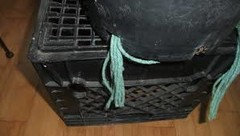
I looked and looked for a picture of someone using the stick-through-a-drainhole-to-drain-more-water-out trick, but couldn't find one. I'll try to stage one in the next week. It's amazing when you're not expecting it, LOL!
Cotton is a good wicking material, the problem with it is that it will rot pretty quickly. As long as you don't mind replacing those wicks regularly, it will work. I would replace a cotton wick every year, because though you MIGHT get 2 years out of it before it starts to rot, you also might not, and end up with nonfunctional wicks halfway through the 2nd year.
However, you might be able to get cotton t-shirts for free or cheap from local thrift stores - they often toss damaged or stained items, or sometimes even stuff they just get too much of. T-shirts these days are usually a 50/50 cotton-poly blend - so wicks made from this will probably be a little bit longer lasting than 100% cotton. I'd still replace them every spring, especially if you're getting them free or for super cheap. Just be sure you don't end up with t-shirts somebody was working on their car in, soaking up oil with, or using while painting and/or cleaning their paintbrushes!
Some people use strands from Rayon mop heads. These also tend to break down (they're made from wood fibers, cellulose) but they are cheap and effective. Al, of Al's gritty mix fame, uses them. Go to the following post and search on "Tue, Jan 1, 13 at 13:24" to go down to the post where he talks about wicking to remove perched water.
Container Soils - Water Movement and Retention XVI
Here is a picture showing the kind of wicking you need to do to drain off that perched water, from the thread above:
{{gwi:6822}}
Now, if we're talking about drawing water UP from the bottom (wicking UP rather than down and out) here are some pictures illustrating that.
You can use almost anything that will absorb water for the wicking - I bet even cut up strips of "super towel" might work, though I don't know how long they might last. But nylon clothesline is a good choice that is cheap and easy to find. You could also buy capillary matting (which comes by the yard in widths up to 72") and cut that into strips. I think that is mostly polyester felt (THICK polyester felt, you won't find it at JoAnn's).
Anyway here are some pictures:
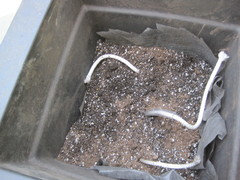
Here's one who used cut up capillary mat:
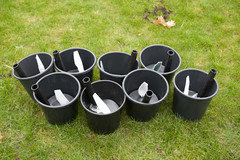
Here are her directions for how she made her pots:
A lot of folks swear by using soil wicking systems. There is a reservoir (or several sometimes in commercially built self watering containers that use this) into which you firmly tamp soil, which will be partly below the water line of the water reservoir in the bottom of the container. Here is a picture showing the system:
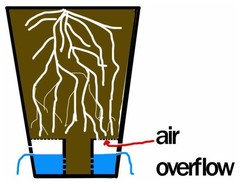
The air space between the water reservoir and the soil is important to this design, and its what makes it different from sitting your pot in water and doing what we think of as conventional "bottom watering".
As for the video links you posted - there are problems with that guy's system. First is the soil medium. Straight MG garden soil is a TERRIBLE medium for a container. That needs to be mixed 1:1 with peat, or even 1:2.
Even so, in our conditions here that isn't an ideal potting medium by a long shot. I've used it for years and so far I am getting away with it here- but I'm not sure I would be getting away with it in a tall container like that, wicking or no wicking.
Second is the way he planted that tomato. Firstly, a 5 gallon bucket is really too small for most tomato plants. Still you can manage with that more or less, if you take a little extra care.
When I plant tomatoes in the ground (or in a raised bed), I snip off all but the top two or three leaves/stems and plant it in a trench with the root ball at least 8" to 10" deep, angled up from there so the top two leaves come out just an inch or two above the soil. I also plant in water catchments (a depression so water is guided to the plant. Because a tomato will root all the way along the stem, and this is one of the best ways to drought-proof your tomato plants.
When planting in a container, I do something similar - I will snip off all but the top 2 or 3 leaves/stems and plant it with just a couple of inches of soil below the root ball, then fill just to where those top few stems are poking up. This will likely be way below the level of the top of the container.
Then as the plant grows, I remove lower stems and add planting medium. This way the tomato roots all the way along that stem and you aren't waiting for the roots to grow down into the bottom of the container - they are already there, and strong and healthy to boot! when I get to within about 3" of the top of the container, I mulch (about 2" of bark).
Then there is your selection of plants. For a 5 gallon bucket, a determinate variety is a must. Also, look for varieties specifically bred as "patio tomatoes" or for containers, such as Celebrity, Bush Champion, Bushsteak, Bush Early Girl, etc. Burpee's has a bunch of varieties specifically for container growth - probably other seed sellers do as well.
I grow determinate paste varieties in small spaces in raised beds when possible, though this year I ended up with Early Girl because that was all that was left by that time (mid-July, we moved at the end of June so my garden went in VERY late).
When I was growing tomatoes in containers, I grew them in cut-off garbage cans instead of the 5 gallon buckets. I just don't feel those are really big enough for tomatoes. Garbage cans were a lot cheaper back then ... but if they go on sale, you might grab some for your tomatoes next year. I use the garbage cans because they are UV stabilized, intended for outdoor use. Other plastic containers usually break down pretty quickly in the sun.
I HAVE grown them in 5 gallon buckets but they were hard to stake, hard to keep from falling over in a wind, and didn't yield as well as when they're in larger containers.
I put the garbage cans up on spaced pavers or concrete brick to improve drainage - but that might not be as much of an issue in LV, with the right potting medium. Just make sure the drainage holes are good sized - like 1/4". Cover with soil fabric or coffee filters to keep the soil from washing out.
You can also build mini-raised beds out of concrete blocks - a raised bed doesn't HAVE to be 4' wide and 10' long. Bonus - for me anyway - is having that thicker edge to sit on when I get tired, LOL!
A concrete block "container" 24" square (internally) would need 2 courses (16 total) of standard 8x8x16" concrete blocks, and you'd then have a 16" tall raised bed to work with which will NEVER wear out (well not in OUR lifetimes). The soil dynamics in a raised bed are MUCH more forgiving than in container growing. The bricks run about $1.50 here when they're not on sale - if you keep your eyes peeled, watch craigslist and your local freelist, etc, you might catch them for less. A concrete block raised bed takes no real skill to build - just lay them out so the corners alternate. With no frost heave you'll be good to go to just lay them out on a level piece of ground.
Hope there are some ideas that might be of use to you.
SynergyCeleste
9 years agolast modified: 9 years agoThanks for the extensive tutorial...It will take me some time to ABSORB it all!
Pyewacket
9 years agolast modified: 9 years agoFYI: I found 40 lb bags of Dry Stall (Pumice) at a local feed store for $13.45. Hoping to pick up a bag today.
Shannon O'Brien
7 years agoI know this is an old thread but there's a lot of newcomers to Vegas who are looking for a gardening advice and I found two web sites that are particularly helpful. Gardeningonmars.com and xtremehorticulture.blogspot.com. both webmasters are extremely responsive to questions frm teaders and they both are quite knowledgeable about gardening in the Mojave and Vegas in particular. I've been here12 years and find that if you want flowers, grow roses (with protection from afternoon sun), bougainvillea, Tecoma stans (gorgeous), cannas, lantana, mandevilla and jasmine. Those have performed the best for me.good luck!
Shannon O'Brien
7 years agoSorry one more thing don't use peat. probably the worst thing you can use in your soil. use coir instead you can get it at Amazon. And if you use sand make sure it's Builders grade otherwise it'll just turn into cement if it's fine sand
Pyewacket
7 years agolast modified: 7 years agoI have found a container mix that works excellently well, and YES it does include peat.
Get the Growstones in the medium size. I've been using roughly 3-2-1 peat-bark-growstone. The peat and bark (try to get small pine bark mulch if you can, avoid the dyed chopped-up-old houses stuff at all costs) provide organic matter and the growstone is better than perlite and provides plenty of oxygen in the root zones.
Drains well, holds moisture well, ends up being VERY lightweight overall, and the growstone can be reused indefinitely. I sterilize by soaking in bleach water (about 5% to 10% bleach). Also cleans out residual organic matter. Growstone doesn't "clog" - it is basically man-made pumice, only even lighter weight.
I've had citrus trees growing in several different mixes and they have done best in the Growstone mixes.
I can no longer get pine bark mulch in anything approaching the correct size, so I may have to try something else when I run out. Or maybe one of the local bulk mulch places will let me go in and get a garbage bag full of mulch (can't handle a truckload - I could USE it, but I can't handle it, LOL!)
Don't use sand. Sand is the most useless potting mix ingredient I can think of - even worse than perlite. It serves no purpose in a soil mix whatsoever, except maybe for something very specialized like cactus, although the local UNR greenhouse uses turface instead for their cacti. But for growing garden vegetables and flowers - avoid sand entirely.
You can get Growstone by the bag - I think 1.5 cu ft - for $25 - $30 at a hydroponics supply store. Don't balk at the high initial cost - you can reuse it practically forever.
Rinse the Growstone before using the first time to wash out dust and reduce the alkalinity. Our water is already pretty alkaline. I usually "float" the Growstone in a five gallon bucket full of water at least overnight - then the dusty bits fall to the bottom and you can just scoop the rest out - it literally floats.
Coir is stupid expensive almost everywhere, even where it grows naturally. And if it hasn't been thoroughly cleaned, can be very high in salinity. Also studies have shown that coir can damage root development and plant growth. Altogether too risky and too expensive when peat works just fine in the proper ration with bark and something like pumice or Growstone. Even in the desert.
The acidity of peat helps to level out the pH of the alkaline Growstone. It's a match made in heaven. And heaven loves a garden.
Sarah Olson
5 years agoOur climate is windy, hot, dry and freezes in the winter. I grow a lot of tomatoes, peppers, onions, basil, cilantro, broccoli, cabbage, cauliflower, cucumbers, melons and strawberries:)

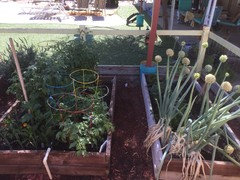
The onions and cilantro will grow all year long. Put in a drip irrigation system in a raised bed. It’s the only way to water properly here. It waters slow and deep and doesn’t burn the plant leaves. Mulch your bed really good in the summer. Tomatoes like a warm sunny climate, but start to burn in the summer blistering heat.chezron
4 years agoAll of this talk about gardening in Las Vegas, yet no names of plants? I don't vegetable garden, so landscape plant names would be appreciated.
Forest Miller
4 years agoChezron, someone mentioned ornamental plants a few posts up. I don't like growing edibles either. I love canna lilies. . .they're gorgeous and stand up to the heat. Roses, lantana, plumeria, bamboo, lots of different vines. Just about everything at Star Nursery grows here but ignore the care tags. "Full sun" doesn't necessarily mean full Las Vegas sun.
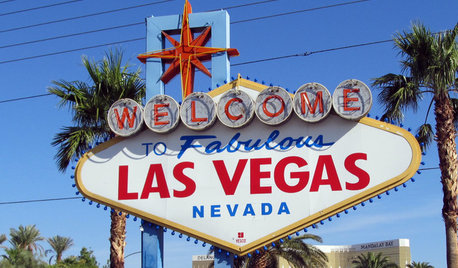
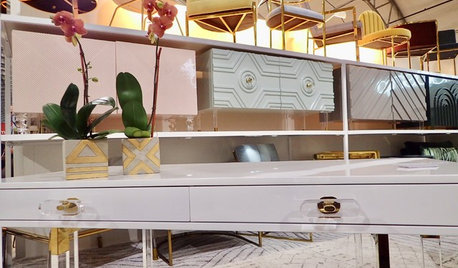
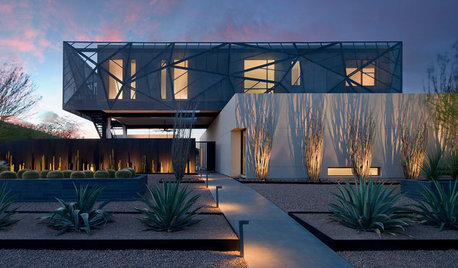

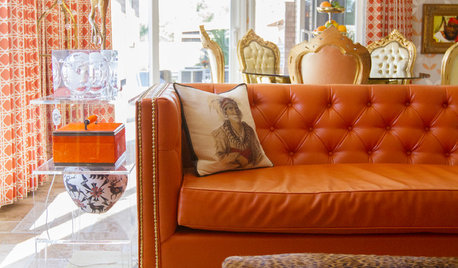
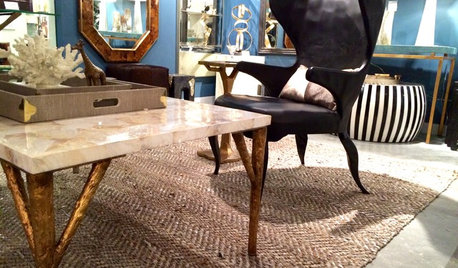
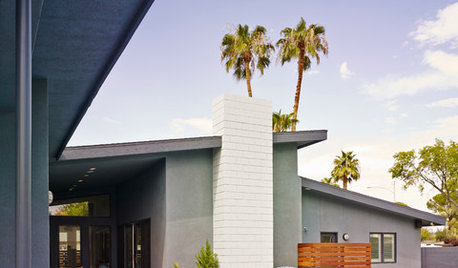

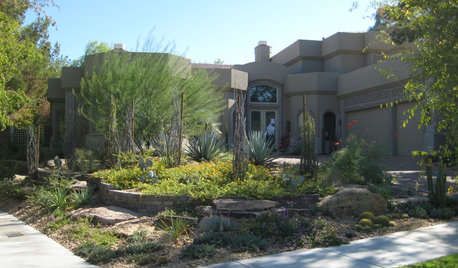
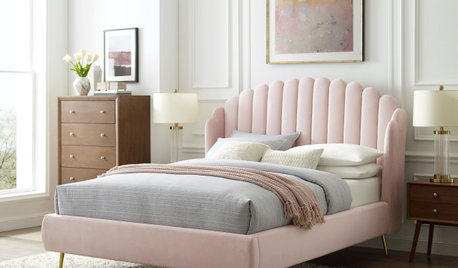






ljrmiller